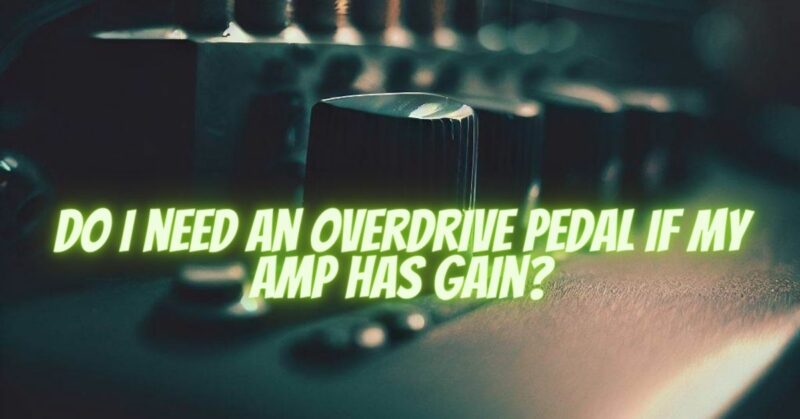For guitarists and bassists, the quest for the perfect tone often involves considering the need for additional pedals to complement their amplifier’s built-in features. One common question that arises is whether an overdrive pedal is necessary if the amp already has a gain control. In this article, we will explore the benefits and considerations of using an overdrive pedal alongside a gain-enabled amp to help you make an informed decision about your setup.
Understanding the Distinction:
Before diving into the specifics, it’s important to understand the distinction between the gain control on your amp and an overdrive pedal. The gain control on your amplifier adjusts the level of preamp distortion within the amp itself, while an overdrive pedal is an external device designed to simulate the natural breakup and overdriven tones of a tube amplifier.
Enhancing Tonal Versatility:
- Expanded Tonal Palette: Using an overdrive pedal in conjunction with your gain-enabled amp can expand your tonal possibilities. The pedal can provide additional gain stages, allowing you to achieve a wider range of overdriven tones beyond what your amp’s built-in gain control can offer.
- Tonal Sculpting: An overdrive pedal can shape your tone by adding unique characteristics and flavors. It can offer different EQ options, boost specific frequencies, or provide additional saturation that complements and enhances the core tone of your amp.
- Boosting and Tightening: An overdrive pedal can act as a boost, driving your amp’s gain further and adding sustain. It can also tighten up the low-end response, particularly useful for high-gain playing styles, allowing for improved note definition and articulation.
Flexibility and Versatility:
- Amp Independence: Incorporating an overdrive pedal allows you to achieve consistent overdriven tones regardless of the amp you’re using. This is particularly beneficial if you perform with different amplifiers in various live or studio settings, providing consistency in your tone.
- Lower Volume Drive: Overdrive pedals can be used to achieve driven tones at lower volumes. This can be advantageous for practicing at home or in situations where volume restrictions are in place, allowing you to attain the desired breakup and sustain without excessive volume levels.
Personal Tonal Preference:
Ultimately, the need for an overdrive pedal alongside a gain-enabled amp depends on personal preference and the specific tones you wish to achieve. While many guitarists find that an overdrive pedal adds versatility and flexibility to their setup, others may be content with the tonal range provided by their amp’s gain control alone.
Experimentation and Fine-Tuning:
Experimenting with various combinations of your amp’s gain control and an overdrive pedal is key to finding your ideal tone. Consider factors such as the pedal’s settings, placement in your signal chain, and how it interacts with your amp’s natural characteristics. It’s important to spend time refining your setup to ensure that the overdrive pedal enhances and complements your amp’s capabilities without overwhelming the core tone.
Conclusion:
While a gain-enabled amp provides its own range of overdriven tones, incorporating an overdrive pedal can offer expanded tonal versatility, additional gain stages, and tailored EQ shaping. An overdrive pedal allows for flexibility, independence from specific amps, and the ability to achieve driven tones at lower volumes. However, the necessity of an overdrive pedal ultimately depends on your personal tonal preferences and the specific sounds you aim to create. By experimenting with different combinations and settings, you can fine-tune your setup to achieve the desired tone and maximize the sonic potential of your rig.


